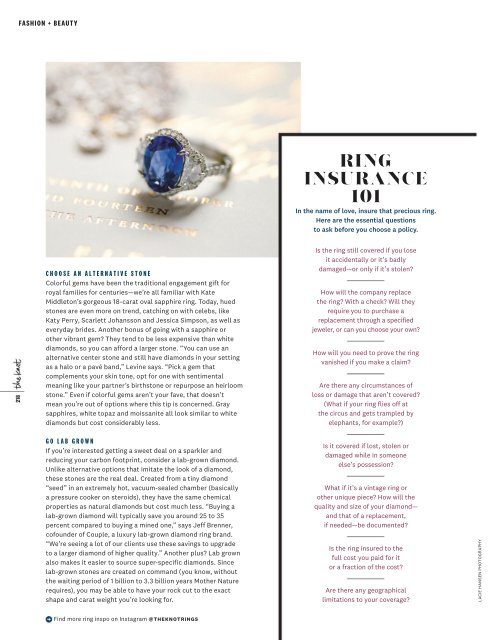The Knot Chicago Weddings Spring Summer 2020_downmagaz.com
Create successful ePaper yourself
Turn your PDF publications into a flip-book with our unique Google optimized e-Paper software.
FASHION + BEAUTY<br />
RING<br />
INSU RA NCE<br />
101<br />
In the name of love, insure that precious ring.<br />
Here are the essential questions<br />
to ask before you choose a policy.<br />
218<br />
CHOOSE AN ALTERNATIVE STONE<br />
Colorful gems have been the traditional engagement gift for<br />
royal families for centuries—we’re all familiar with Kate<br />
Middleton’s gorgeous 18-carat oval sapphire ring. Today, hued<br />
stones are even more on trend, catching on with celebs, like<br />
Katy Perry, Scarlett Johansson and Jessica Simpson, as well as<br />
everyday brides. Another bonus of going with a sapphire or<br />
other vibrant gem? <strong>The</strong>y tend to be less expensive than white<br />
diamonds, so you can afford a larger stone. “You can use an<br />
alternative center stone and still have diamonds in your setting<br />
as a halo or a pavé band,” Levine says. “Pick a gem that<br />
<strong>com</strong>plements your skin tone, opt for one with sentimental<br />
meaning like your partner’s birthstone or repurpose an heirloom<br />
stone.” Even if colorful gems aren’t your fave, that doesn’t<br />
mean you’re out of options where this tip is concerned. Gray<br />
sapphires, white topaz and moissanite all look similar to white<br />
diamonds but cost considerably less.<br />
Is the ring still covered if you lose<br />
it accidentally or it’s badly<br />
damaged—or only if it’s stolen?<br />
How will the <strong>com</strong>pany replace<br />
the ring? With a check? Will they<br />
require you to purchase a<br />
replacement through a specified<br />
jeweler, or can you choose your own?<br />
How will you need to prove the ring<br />
vanished if you make a claim?<br />
Are there any circumstances of<br />
loss or damage that aren’t covered?<br />
(What if your ring flies off at<br />
the circus and gets trampled by<br />
elephants, for example?)<br />
GO LAB GROWN<br />
If you’re interested getting a sweet deal on a sparkler and<br />
reducing your carbon footprint, consider a lab-grown diamond.<br />
Unlike alternative options that imitate the look of a diamond,<br />
these stones are the real deal. Created from a tiny diamond<br />
“seed” in an extremely hot, vacuum-sealed chamber (basically<br />
a pressure cooker on steroids), they have the same chemical<br />
properties as natural diamonds but cost much less. “Buying a<br />
lab-grown diamond will typically save you around 25 to 35<br />
percent <strong>com</strong>pared to buying a mined one,” says Jeff Brenner,<br />
cofounder of Couple, a luxury lab-grown diamond ring brand.<br />
“We’re seeing a lot of our clients use these savings to upgrade<br />
to a larger diamond of higher quality.” Another plus? Lab grown<br />
also makes it easier to source super-specific diamonds. Since<br />
lab-grown stones are created on <strong>com</strong>mand (you know, without<br />
the waiting period of 1 billion to 3.3 billion years Mother Nature<br />
requires), you may be able to have your rock cut to the exact<br />
shape and carat weight you’re looking for.<br />
Is it covered if lost, stolen or<br />
damaged while in someone<br />
else’s possession?<br />
What if it’s a vintage ring or<br />
other unique piece? How will the<br />
quality and size of your diamond—<br />
and that of a replacement,<br />
if needed—be documented?<br />
Is the ring insured to the<br />
full cost you paid for it<br />
or a fraction of the cost?<br />
Are there any geographical<br />
limitations to your coverage?<br />
LACIE HANSEN PHOTOGRAPHY<br />
Find more ring inspo on Instagram @THEKNOTRINGS



